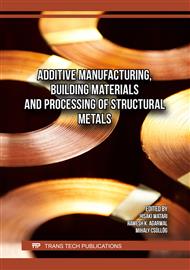p.9
p.15
p.23
p.31
p.37
p.53
p.61
p.67
p.79
Analysis and Testing of Infills of 3D Printed Specimens with Varying Infills
Abstract:
The study focuses on the stress-strain behavior of 3D-printed infill patterns with two different infill densities, which are 15% and 30%, to analyze their performance. The stress-strain behavior of a material describes how it deforms and reacts under different stress levels. The stress will be calculated in MPa and the strain in [%]; an example is the stress of gyroid in fill was 19.167 MPa while the average strain was 2.7833 % at 15% infill density. Using a tensile test machine with an optical extensometer, we would like to find out how infilled densities and parameters affect stress and strain. An Anycubic Kobra 3D printer with PLA filament from Anycubic was used for each sample. All the infills in the Ultimaker Cura software are being used.Additive manufacturing techniques are still in a process where further testing is required until we can perfectly control the results through specific instructions in the software. These tests can lead to forces of the required stress and strain, high quality where required, and products that use lower amounts of infills but still have high stress/strain. The main purpose is to further understand the forces we observe with every infill and independently analyze the stress and strain outputs. This will also lead to lower material usage in the FDM printing technology when a product is prepared.Two tests are designed to support the results and decision process, the tests have different properties such as layer height, wall layer counts, infill density, and top and bottom layer thickness. The tests with different properties were analyzed to check the best results and find the most suitable material effect and force difference due to material densities, wall thickness, and other properties. These properties show large differences in results, such as a 20% strain increase in the Quarter cubic infill. The highest strain was observed in concentric infill with 30% infill.
Info:
Periodical:
Pages:
37-52
Citation:
Online since:
June 2025
Authors:
Price:
Сopyright:
© 2025 Trans Tech Publications Ltd. All Rights Reserved
Share:
Citation:



